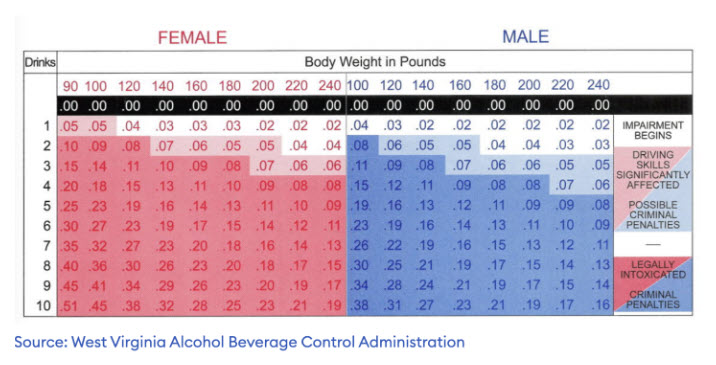Have you ever been out to the bar, had a couple of drinks, then wondered if you were sober enough to drive home? Before you get into that situation, you can use the Department of Motor Vehicles’ Blood Alcohol Concentration (BAC) chart to get a sense of how many drinks it takes before it’s not safe for you to drive.
This chart shows estimated blood alcohol concentration (BAC) levels for men and women at certain body weights and how many drinks it takes to get to that BAC. These numbers are estimates and should only be used as a guide.

This chart is based on one standard drink or one ounce of 100% alcohol. However, most alcoholic beverages are not measured in standard drinks, so here’s how you’ll most likely consume a standard drink:
- 1 oz 100% alcohol – This could also be a shot of liquor
- 1.5 oz 80% alcohol – A standard cocktail
- 5 oz 12% wine – A standard pour of white or red wine
- 12 oz of 5% beer – Note that IPAs and lagers may have a higher alcohol content
Using the chart, you’ll notice that one standard drink will increase your BAC by a minimum of 0.02%, with the effect more significant the lower your weight. However, that effect doesn’t come immediately after you drink. It takes some time, usually anywhere between 30 to 90 minutes for the alcohol to go from your stomach into your bloodstream, so it will take some time for the alcohol to affect you. Additionally, after you drink, your body will start getting the alcohol out of your system and will continue to do so until it’s gone. Your BAC will drop at a set rate, usually between 0.01% to 0.015%, every hour after you last drank. This is also somewhat dependent on your weight and gender, but usually, nobody eliminates alcohol faster than 0.015%.
Notice that the elimination rate is lower than the rate that a standard drink can increase your BAC. So, if you have one standard drink and then don’t drink anything for the rest of the night, your BAC will rise to 0.02% – 0.05%, and then it will take two or more hours before that alcohol is eliminated from your body. This means that you may feel the effects of the alcohol for a lot longer than you think and may be impaired by the alcohol for a longer time than you realize.
Difference Between BAC and Impairment
This chart measures what your BAC might be based on your gender, weight, and how many drinks you’ve had, but it doesn’t tell you how you’ll be affected by those drinks. While it’s likely that the higher your BAC is, the more impaired you will be, there are other factors that also affect your impairment. Those factors include:
- Whether you’ve eaten right before or while drinking
- How tired you are
- How much water you’ve drank
- What kind of medications you’re taking
- If you have any medical issues, mainly related to your stomach or liver
So, while your BAC may be low, you may actually be impaired by the alcohol, and it may be unsafe for you to drive. That’s why the BAC level is important in a DUI case.
This chart only provides an estimate of the BAC you may be at after a standard drink. That means your BAC could be higher than the listed BAC, and you may be more impaired than the chart suggests. The chart also doesn’t account for drinks with multiple alcohols in them, which will absolutely affect you differently. So, please don’t use this chart to convince yourself you can drink more without getting to a 0.08% BAC because that might not actually be the case.
The attorneys at Lamano Law Office are well-versed in the science behind DUIs and BAC. We can help you understand your case and your situation better. For more information, please contact info@lamanolaw.com.
